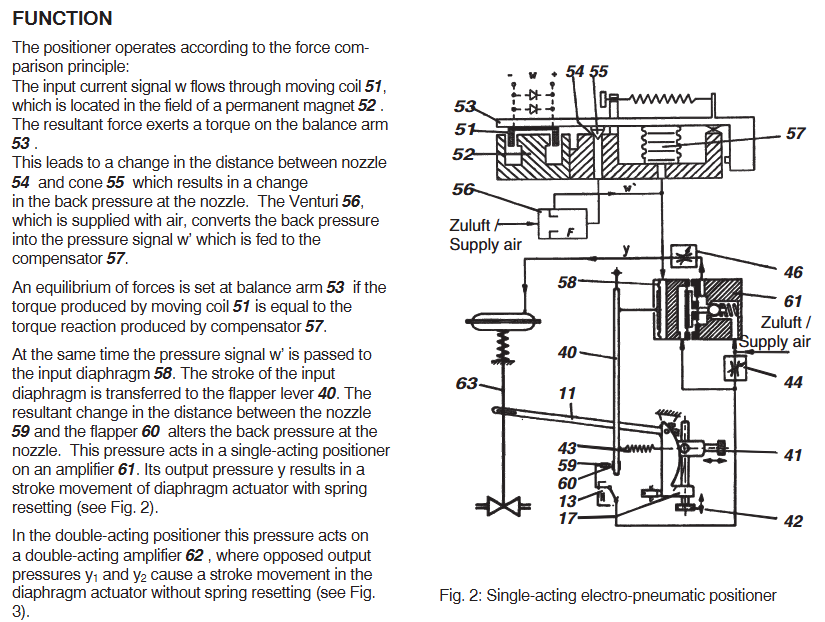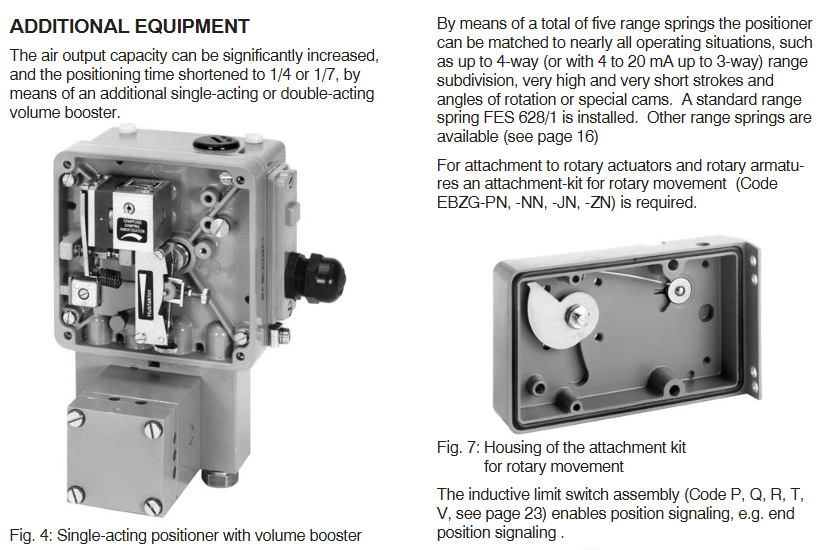Eckardt SRI986 Intelligent Valve Positioner
HART version: 12-30 V DC (typical power consumption 1.5 W);
PROFIBUS PA version: 9-32 V DC (compliant with IEC 61158-3 power supply standard).
Gas source requirements:
Pressure: 0.2-1.0 MPa (clean and dry compressed air, filtration accuracy ≤ 5 μ m, dew point 10 ℃ lower than ambient temperature);
Gas consumption: Double acting ≤ 0.3 Nm ³/h (steady state), single acting ≤ 0.2 Nm ³/h (steady state).
(3) Environment and Certification
Protection level: IP66 (dustproof and waterproof), IP67 (short-term immersion), IP68 (long-term immersion, optional);
Temperature range: -40~+85 ℃ (conventional), -55~+100 ℃ (high temperature option), -20~+60 ℃ (intrinsic safety version);
Explosion proof certification:
ATEX:Ex d IIC T6 Ga(Zone 1)、Ex nA IIC T6 Gc(Zone 2);
IECEx:Ex d IIC T6 Ga、Ex nA IIC T6 Gc;
CSA:Class I Div 1/2,Groups A-D,T6。

Operation and configuration process
1. Installation and initialization
(1) Mechanical installation
Bracket fixation: Select the corresponding bracket according to the type of actuator (straight stroke/angular stroke), and fix the locator with ISO 5211 flange (straight stroke) or shaft sleeve (angular stroke) to ensure that the connecting shaft is coaxial with the actuator shaft (deviation ≤ 5 °).
Air source connection: Connect clean compressed air to the "Supply" port (G1/4 thread) of the locator. Single acting mechanisms need to distinguish between "Output" (working side) and "Exhaust" (exhaust side), while double acting mechanisms need to distinguish between "Open" and "Close" ports.
Electrical wiring: The HART version is connected to a 12-30 V DC power supply and a 4-20 mA signal (two-wire system); The PROFIBUS PA version is connected to the bus power and signal lines (two-wire system), and the wiring terminals must meet explosion-proof sealing requirements (such as using explosion-proof gland heads).
(2) Auto Tune
Starting conditions: Ensure that the air source pressure is normal (0.2-1.0 MPa), the actuator is not stuck, and the locator is powered on (power light is always on).
Trigger self-tuning:
Local: Long press the "Auto Tune" button on the locator (3 seconds), the indicator light will flash (red), and enter self-tuning mode;
Remote: Send the "Auto Tune" command through a HART controller or control system.
Process and completion: The locator automatically drives the actuator to run throughout the entire stroke (2-3 times), records parameters such as stroke time and response characteristics, and optimizes PID parameters; After the self-tuning is completed, the indicator light turns green and stays on, and the system enters normal control mode.
2. Daily operations and diagnosis
(1) Local operation
Status indication: Judging the operating status through 3 LED lights——
Green constantly on: normal operation; Green flashing: self-tuning in progress;
Yellow constantly on: warning (such as low gas supply pressure, slight jamming); Yellow flashing: communication failure;
Red constantly on: serious malfunction (such as position sensor failure, actuator jamming); Red flashing: Over range alarm.
Manual adjustment: Long press the "Manual" button (3 seconds) to enter manual mode, adjust the valve opening through the "Up"/"Down" buttons, and release the button for 5 seconds to automatically return to automatic mode (to prevent misoperation).
(2) Remote diagnosis (HART/PROFIBUS PA)
The following key data and diagnostic information can be read through a handheld device or control system:
Operating data: actual valve opening (%), set value (%), supply pressure (MPa), output pressure (MPa), working temperature (℃);
Diagnostic information:
Mild malfunction: low gas supply pressure (<0.2 MPa), slow response of the actuator (jamming warning);
Severe faults: position sensor failure, piezoelectric valve failure, communication interruption;
Maintenance tips: valve action frequency (cumulative), last maintenance time, recommended maintenance cycle (such as checking the air circuit every 100000 actions).

Configuration options and ordering information
1. Core configuration options
Applicable scenarios for configuring category options
Communication protocol HART 7.0 (standard), PROFIBUS PA (optional) HART: for small and medium-sized systems, low cost; PROFIBUS PA: A large-scale bus system that requires multiple devices to be networked
Type of actuator: Linear, Rotary. Linear: Globe valve, gate valve; Angular stroke: butterfly valve, ball valve
Explosion proof rating Ex d IIC T6 (standard), Ex ia IIC T4 (intrinsic safety, optional) Ex d: Zone 1/2, suitable for high-risk areas; Ex ia:Zone 0/1, Suitable for extremely high-risk areas
Protection level IP66/IP67 (standard), IP68 (optional, water depth 1m/24h) IP68: humid environment (such as sewage treatment plant, outdoor during rainy season)
Materials and coatings: Aluminum alloy shell (conventional), stainless steel shell (optional), corrosion-resistant coating (PTFE, optional) Stainless steel+PTFE: corrosive environment (such as chemical acid/alkali gas)
2. Typical ordering models
Eckardt SRI986 model coding rule: SRI986- [Protocol] - [Type of actuator] - [Explosion proof level] - [Protection level], example as follows:
- EMERSON
- Honeywell
- CTI
- Rolls-Royce
- General Electric
- Woodward
- Yaskawa
- xYCOM
- Motorola
- Siemens
- Rockwell
- ABB
- B&R
- HIMA
- Construction site
- electricity
- Automobile market
- PLC
- DCS
- Motor drivers
- VSD
- Implications
- cement
- CO2
- CEM
- methane
- Artificial intelligence
- Titanic
- Solar energy
- Hydrogen fuel cell
- Hydrogen and fuel cells
- Hydrogen and oxygen fuel cells
- tyre
- Chemical fiber
- dynamo
- corpuscle
- Pulp and paper
- printing
- fossil
- FANUC
- Food and beverage
- Life science
- Sewage treatment
- Personal care
- electricity
- boats
- infrastructure
- Automobile industry
- metallurgy
- Nuclear power generation
- Geothermal power generation
- Water and wastewater
- Infrastructure construction
- Mine hazard
- steel
- papermaking
- Natural gas industry
- Infrastructure construction
- Power and energy
- Rubber and plastic
- Renewable energy
- pharmacy
- mining
- Plastic industry
- Schneider
- Kongsberg
- NI
- Wind energy
- International petroleum
- International new energy network
- gas
- WATLOW
- ProSoft
- SEW
- wind
- ADVANCED
- Reliance
- YOKOGAWA
- TRICONEX
- FOXBORO
- METSO
- MAN
- Advantest
- ADVANCED
- ALSTOM
- Control Wave
- AB
- AMAT
- STUDER
- KONGSBERG
- MOTOROLA
- DANAHER MOTION
- Bently
- Galil
- EATON
- MOLEX
- Triconex
- DEIF
- B&W
- ZYGO
- Aerotech
- DANFOSS
- KOLLMORGEN
- Beijer
- Endress+Hauser
- MOOG
- KB
- Moxa
- Rexroth
- YAMAHA
- Johnson
- Westinghouse
- WAGO
- TOSHIBA
- TEKTRONIX


Email:wang@kongjiangauto.com



































































































































